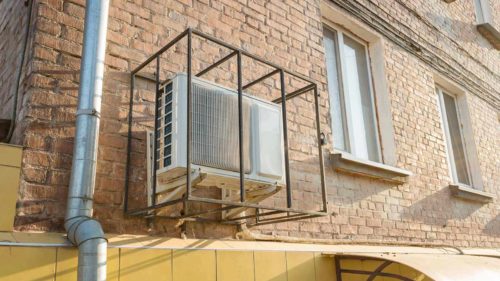Air conditioning unit, ventilation system on the wall. Summer hot sunny day.

We Need a New Approach to Cooling
The world’s first air conditioner was developed in 1902 to remove humidity from a building. Willis Carrier’s invention, that enabled the precise control of temperature and humidity, became the fundamental building block for modern air conditioning, evolving through the 1920s into air conditioners to provide cooling to the built environment. Over the 118 years since it’s invention, the same fundamental science underpins today’s air conditioners albeit incorporating new materials, electronic controls, and increased efficiencies.
Great advances have been made in the affordability of air conditioners (ACs)—enabling large-scale adoption in developed countries around the world, and rapidly accelerating demand in developing countries in the hotter climate zones around the tropics. In our increasingly warming world, the projected growth in room air conditioners alone amounts to 10 new ACs sold every second for the next 30 years!
At the same time, the actual efficiency of deployed technology is far behind what has been demonstrated to be achievable. While critically important to human thermal comfort and well-being, the growth in the number of air conditioners around the world portends serious impacts to energy systems and the environment. We have to take a different path if we are to avoid the damaging cycle of increased growth in air conditioning further accelerating global warming.
In many regions of the world, the most stringent energy performance standards for ACs lag significantly behind the best commercially available ACs. And in fact, the best commercially available ACs are not even reflective of what is technically achievable and feasible today. A mass adoption of the best commercially available technology could deliver today’s air conditioning needs with around 50 percent less energy use, with significantly lower lifecycle cost to consumers. And if we strive for what is technically achievable, the positive impacts could be exponentially greater.
The Global Cooling Prize—an innovation challenge launched by RMI and global partners—has identified eight viable technology solutions that can potentially deliver residential cooling with five times less climate impact than today’s most commonly sold units. The solutions do this through a combination of significantly enhanced energy efficiency and no- or low-global warming potential (GWP) refrigerants.
It’s About More than Just the Technology
As we seek new solutions for thermal comfort, it is also important to step away from the default approach of air conditioning buildings: the primary goal is, in fact, to provide cooling comfort to people. This can be achieved through regulating air temperature, humidity, and ventilation/air flow, and enabling people to use adaptive techniques to achieve their desired personal comfort. As part of this, directly providing independent and efficient humidity control is very important, versus the present energy-intensive approach of overcooling with an AC to the dew point to dehumidify the space.
Beyond cooling technologies, there are two additional factors that play a key role in indoor thermal comfort. The first one is how people utilize cooling. In this regard, the role of behavior adaptation is important. The theory of adaptive thermal comfort suggests that human connection to the outdoors and control over the immediate environment allows people to adapt to—and even prefer—a wider range of thermal conditions than is generally considered comfortable.
An adaptive approach to thermal comfort could have a tremendous impact on comfort conditions in buildings and on resulting energy consumption—to the tune of around 15 percent reduction if we shifted our cooling thermostat from 72°F to 78°F, as RMI analysis suggests. The role of smart controls that would enable part-time and part-space operation is also increasingly important in optimizing the cooling energy use.
The second factor is the thermal efficiency of buildings, driven by careful envelope design and other passive cooling measures such as shading and proper ventilation. Thermally efficient buildings can reduce the requirement for mechanical cooling, and are therefore foundational to climate-friendly cooling and should be pursued to the fullest extent possible. RMI’s high-level analysis shows that enhancing the thermal performance of a building, through cost-effective envelope improvements alone, can reduce the energy requirement for mechanical cooling by approximately 10 to 15 percent.
The Challenge Lies in Adoption
Collectively, the above-mentioned strategies—using the best commercially available ACs, improving the building envelope, and utilizing an adaptive approach to thermal comfort—where cost-effectively applicable in today’s building stock, could have achieved today’s air conditioning needs with just over one-third of the energy use. This would have saved more than 1,300 terrawatt hours annually.
This means that nearly 550 GW of power generation capacity to meet space cooling needs could have been avoided, translating to around US$ 385 billion in capital investment (not including the associated transmission and distribution costs) that could have been directed to address other priorities. The total indirect emissions from space cooling operations could have been reduced by 60 percent, with further reduction potential from lower GWP refrigerants and their associated direct emissions.
Given the tremendous benefits—lower lifecycle cost for the users, reduced need for additional power generation, and dramatically lower climate impacts—not pursuing this path now simply due to a higher first cost of efficient cooling choices makes no sense. While the pursuit of radically more efficient cooling technologies remains important, creating mass awareness and enabling means to overcome the first-cost barrier are equally if not more urgent needs in the pursuit of climate-friendly cooling. Substantial benefits are within reach today, but this will take a coordinated effort across policymakers, industry, and major property owners to drive the much-needed change toward addressing thermal comfort needs without warming the planet.


